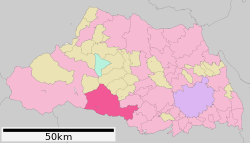Hanno, Saitama
|
Hannō 飯能市 |
|||
|---|---|---|---|
| City | |||

View of Hannnō from Mount Tenran
|
|||
|
|||
 Location of Hannō in Saitama Prefecture |
|||
| Coordinates: 35°51′20.4″N 139°19′39.8″E / 35.855667°N 139.327722°ECoordinates: 35°51′20.4″N 139°19′39.8″E / 35.855667°N 139.327722°E | |||
| Country | Japan | ||
| Region | Kantō | ||
| Prefecture | Saitama Prefecture | ||
| Government | |||
| • -Mayor | Masaru Okubo (since August 2013) | ||
| Area | |||
| • Total | 193.05 km2 (74.54 sq mi) | ||
| Population (February 2016) | |||
| • Total | 80,658 | ||
| • Density | 418/km2 (1,080/sq mi) | ||
| Time zone | Japan Standard Time (UTC+9) | ||
| - Tree | Cryptomeria japonica | ||
| - Bird | Cettia diphone | ||
| Phone number | 042-973-2111 | ||
| Address | 1-1 Namiyanagi, Hannō-shi, Saitama-ken 357-8501 | ||
| Website | Official website | ||
Hannō (飯能市 Hannō-shi?) is a city located in southern Saitama Prefecture, in the central Kantō region of Japan. As of 1 February 2016[update], the city had an estimated population of 80,658 and a population density of 418 persons per km². Its total area was 193.05 square kilometres (74.54 sq mi).
Hannō is located on the southern border of Saitama Prefecture, bordered by the Tokyo metropolis to the south and the Chichibu region to the west. Both the Iruma River and the Koma River flow through the city. Hannō is mainly made up of urban and suburban areas, surrounded by mountains and rivers.
Hannō was traditionally noted for its lumber industry, which developed during the Edo period to supply Edo with timber needed for rebuilding after its frequent fires.
The modern town of Hannō was established within Koma District, Saitama with the establishment of the municipalities system on April 1, 1889. Koma District was abolished in 1896, becoming part of Iruma District.
Hannō annexed the neighboring villages of Seimei, Minami-Koma, Kaji and Moto-Kaji on April 1, 1943. It was elevated to city status on January 1, 1954. Hannō annexed the neighboring villages of Agano, Gigshi-Agano, Haraichiba on September 30, 1956 On January 1, 2005, the village of Naguri was merged into Hannō.
The economy of Hannō is mixed, with a number of pharmaceutical firms and electronics firms maintaining factories in the area. A substantial fraction of the population commutes to Tokyo every day.
...
Wikipedia



